South Fork Holston River Monitoring
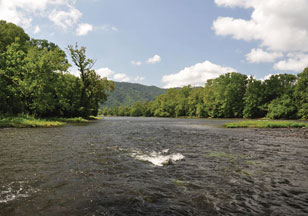
The view downstream at Zone 5 on the South Fork Holston River.
For more than 45 years, Eastman Chemical Company has demonstrated a continuing concern for the health of the aquatic life in the South Fork Holston and Holston rivers near Kingsport, TN, through its sponsorship of environmental studies conducted by the Patrick Center for Environmental Research at The Academy of Natural Sciences of Drexel University. The Academy, founded in 1812, is a world-renowned, private nonprofit institution dedicated to increasing knowledge of the natural world through environmental research and natural history education. The Academy has conducted a lengthy series of environmental studies, initiated in 1965, and repeated in 1974, 1977, 1980, 1990, and 1997 on that portion of the Holston River watershed located near Eastman’s Tennessee Operations facility in Kingsport, TN. The studies document water quality within selected zones of the South Fork Holston River, the Holston River, and Horse Creek. Academy researchers compare the results for each zone to those of the other zones in order to gauge the impact a variety of stressors may have on ecosystem “health”, and the results of the current studies are compared to previous Academy studies to understand changes over time.
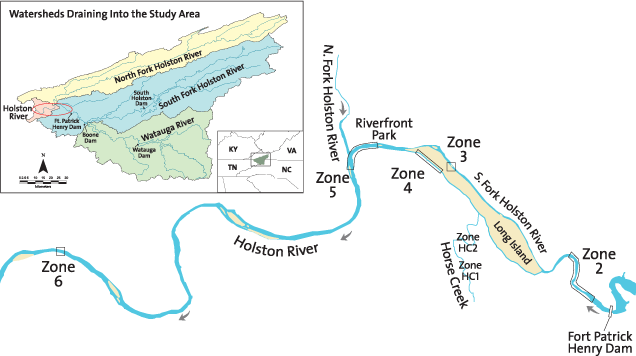
Map of the Academy’s 2010 study area. Water quality in each of the four watersheds (insert, upper left) that drain into the study area (red oval) may be affected by a variety of stressors including land use, erosion, and point and non-point discharges.
The most recent studies were conducted during July 2010 and focused on zones on the South Fork Holston River (Zones 2, 3, and 5), the Big Sluice (Zone 4), the Holston River (Zone 6), and two zones along Horse Creek (see maps above). Water, algae and aquatic plants, macroinvertebrates (e.g., aquatic insects, crayfish, snails), and fish were sampled throughout the study area. The Holston River system in the vicinity of Kingsport is complex, and the biological communities found there are potentially affected by a number of man-made influences. These include the impoundment of the river in a series of upstream reservoirs, particularly the Fort Patrick Henry Dam immediately upstream of the Academy study area, as well as industrial and municipal discharges, and run-off from cities and farms. Efforts to control these influences are achieving success.
The 2010 studies, when compared to Academy river surveys before 1990, show continued improvements in the ecological condition at most of the zones throughout the study area. An overview of the study elements is provided in this online report.
History of Holston River Monitoring
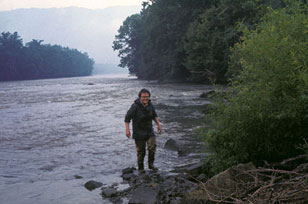
Dr. Ruth Patrick on the South Fork Holston River at Zone 5 in 1965.
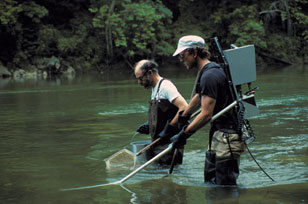
Dr. Richard J. Horwitz (left) and Paul Overbeck using a backpack electrofishing unit to collect large fish at Zone 2 during the 1990 survey.
The Academy’s South Fork Holston and Holston River environmental monitoring program began in 1965 when Dr. Ruth Patrick, a pioneer in the use of multiple levels of the aquatic food chain (e.g., algae, aquatic insects, and fish) to evaluate the health of a stream or river, led the first study in the vicinity of Kingsport. Many of the biologists and chemists that collected during 2010 have over 20 years' experience sampling the River and Horse Creek. With over 100 years of experience collecting on the South Fork and Holston rivers, the Academy staff is very familiar with the historic changes that have taken place within the watershed.
Environmental Chemistry
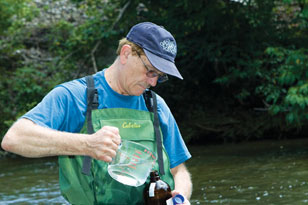
Senior chemist, Paul Kiry, collecting a water sample at Zone 4.
The 2010 water chemistry studies were designed to provide Academy biologists with basic water quality information, such as dissolved oxygen, pH, temperature, biological oxygen demand, and nutrients. Measurements recorded on-site and samples collected and analyzed in the laboratory provide an indication of the conditions at the time the samples were collected. Although such data provide only a short-term picture of water quality, Academy researchers use the information to better understand the results of their biological collections. For example, levels of nutrients, such as nitrogen and phosphorus, are important in evaluating the presence or absence of algae and aquatic plants. Likewise, reduced dissolved oxygen levels in a stream zone may help to explain differences in macroinvertebrate or fish community composition. In addition, the Academy has been conducting these studies since 1965 and these data can be used to look at long-term changes in water quality of the river.
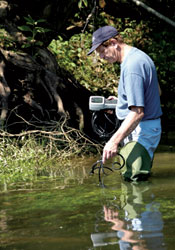
Paul Kiry taking water quality measurements at Zone 2.
Several water quality tests, including total alkalinity, total hardness, dissolved major ions, total nitrogen, total phosphorus, ortho-phosphorus, and dissolved organic carbon (DOC) showed increased concentrations downstream throughout the study area, possibly reflecting the change in land use from more forested to urban. Dissolved oxygen (DO) and water temperature were lowest at Zone 2, which is closest to the bottom-release Fort Patrick Henry Dam. Typically, DO levels are lowest in the deeper portions of most dams.
A few parameters showed elevated levels in Horse Creek (compared to most or all of the five river zones), including turbidity, conductivity, total solids, some dissolved major ions, soluble organic nitrogen, total phosphorus, DOC, and total organic carbon. DO and % DO saturation were also lower in Horse Creek than in the river zones. Differences in water quality parameters between Horse Creek and Zones 2-6 may be attributable to lower Horse Creek discharges and more agricultural/recreational land uses within the Horse Creek subwatershed.
Water chemistry parameters observed in 2010 continued to show substantial improvement over the levels measured in the initial studies during the 1960s and early 1970s. Generally, the concentrations observed in the river were similar to the levels measured during the 1997 study.
Notable improvements in water quality have taken place in the Holston River watershed over the 45-year period of these studies. Over the past 20 years the results of the on-site chemistry measurements and laboratory analyses appear to be stable with no substantive change. A few parameters, such as dissolved nitrate plus nitrite and dissolved chloride, show recent slight increases following earlier declines; however, the 2010 concentrations are similar to or lower than those seen during the earliest studies. These increases may result from land development and population growth within the watershed.
Algae and Aquatic Plants
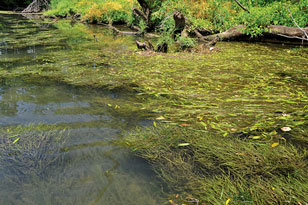
A mixed stand of American waterweed, long-leafed pondweed, and sago pondweed at Zone 3. Submerged aquatic vegetation provides food and shelter for a wide variety of macroinvertebrates and fishes.
Situated at the base of the food chain, algae play an important role in determining the ecological condition of any stream or river. They also serve as ideal monitoring organisms whose community composition directly reflects water quality over an extended period of time. The 2010 studies were designed to evaluate the current environmental conditions by comparing the numbers and types of algae and aquatic plants among the various zones.
Filamentous forms of algae, which can indicate nutrient enrichment when abundant, were found consistently at all zones and in greater abundance in 2010 than in 1997. The abundance of diatom species indicates that parts of the river bottom were affected by high nutrients, a result similar to the previous four surveys (1977-1997). The largest algal growths in 2010 were small “streamers” of green algae on silt-covered rocks in slow to moderate flow.
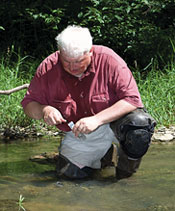
Phycologist Frank Acker scraping algae from the rocks in Horse Creek.
In 2010, the major differences in the diatom communities were between the two Horse Creek zones and Zone 2, as compared to Zones 3-6. The diatom communities at the Horse Creek zones were influenced by higher turbidity and alkalinity, but the impacts to the algal communities in Zone 2 were more dam-related. There were more planktonic algae at Zone 2 and greater amounts of diatoms that could withstand periodic drying than in other downstream zones, both conditions related to larger water fluctuations due to Fort Patrick Henry Dam operations.
Beds of submerged aquatic vegetation (SAV) were observed throughout the study area, particularly at Zones 3 and 6, and appeared more extensive than in previous surveys at several zones. Although there are many factors that explain the presence and absence of aquatic plants, the extent of plant material at several of the zones, especially Zones 2 and 3, was indicative of organic enrichment. However, there has been substantial variation in the amount of SAV recorded during our historic surveys, making it difficult to determine any trends in water quality.
Comparisons of the algal and aquatic plant communities in 2010 with previous studies reveal few differences from the 1990 and 1997 studies. However, there was much improvement from conditions observed in the 1960s and the early 1970s.
Macroinvertebrates
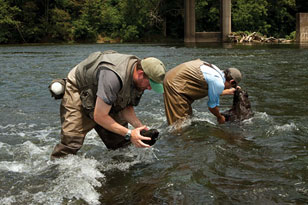
Dr. Raymond W. Bouchard Jr. (left) and Sylvan Klein collecting macroinvertebrates at Zone 6.

Helgrammites (left), damselflies (center), and crayfish (right) are key elements of the benthic macroinvertebrate fauna of the South Fork Holston and Holston rivers.
Macroinvertebrates such as aquatic insects, crayfish, freshwater mussels, and worms are widely used as indicators of water quality in small streams and large rivers throughout the United States. Their limited mobility and responses to a wide range of environmental conditions make them effective in monitoring water quality over long periods of time. In addition, many macroinvertebrates provide the link in the aquatic food chain between algae and animals that occupy higher feeding levels, like fish.
The 2010 studies included non-insect macroinvertebrate and aquatic insect elements with extensive dip netting and hand collections throughout a variety of habitats within each zone. A quantitative survey of aquatic insects and other macroinvertebrates living in shallow water riffle habitats was also conducted.
Thirty-nine different types of non-insect macroinvertebrates, the highest total recorded, were collected during the 2010 survey. They included 3 species new to the survey, among the 10 snail, 7 crustacean, 8 leech, 4 worm, and 5 clam taxa collected.
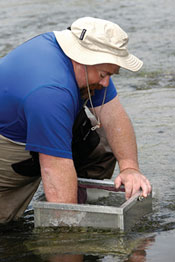
Brett Marshall using a Portable Invertebrate Box Sampler to collect aquatic insects at Zone 4.
The 2010 non-insect macroinvertebrate study indicates impacts at Zones 2, 3, and 4 compared to Zones 5 and 6. Conditions at Zone 6 and both Horse Creek zones in 1997 were similar in 2010, and improved at Zones 2, 3, and 5. These findings indicate a continued and marked improvement in ecological condition since the first Academy survey in 1965.
More than 120 kinds of aquatic insects were recorded during the 2010 quantitative study, with significantly more taxa at Zone 3 than in previous surveys. The numbers and diversity of aquatic insect taxa steadily increased downstream from Fort Patrick Henry Dam, suggesting improved water quality. The dam’s influence on aquatic insect communities appeared to be more extreme than in 1997. Changes in dam operations and subsequent impacts on river flow and elevation may limit the river bottom habitat available for macroinvertebrate colonization below the dam.
The numbers of aquatic insect taxa recorded in 2010 from Zones 3-6 were higher than in previous years, particularly at Zone 3, where damselflies and dragonflies were abundant in the beds of aquatic plants. The 2010 aquatic insect diversity within Horse Creek was similar to the 1997 survey.
Fish
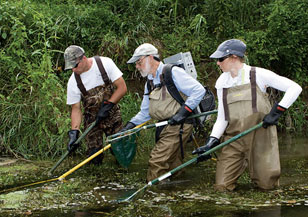
Dr. Richard J. Horwitz (center) with Corey Click (left), and Michelle Brannin (right) sampling smaller fishes with a backpack electrofishing unit.
The numbers and diversity of fish species are important factors in assessing water quality in rivers, lakes, and streams. Fish occupy the highest level in the aquatic food chain and therefore are often used as key indicators of the “health” of aquatic ecosystems.
Approximately 4,000 fish, comprising 47 species, were collected in the 2010 survey. The Tennessee snubnose darter was the most abundant species. Several species, including mimic shiner, mountain madtom, speckled darter, striped bass, and shorthead redhorse, were collected for the first time in Academy studies near Kingsport. Overall, the five most widely distributed species among all zones were the Tennessee snubnose darter, telescope shiner, central stoneroller, greenside darter, and smallmouth bass.
There was a general pattern of increasing species diversity and numbers of fish from Zones 2 through 6. The fish communities and distribution of fish most likely reflects the obvious impacts of dam operations on the river (variations in temperature, water depth, and current speed). Given the variability in stream flow conditions downstream from Zone 2 due to the dam operations, it is difficult to separate out possible impacts of the other potential stressors in the Kingsport area.
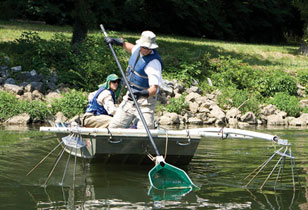
Dave Keller (with net) and Paul Overbeck using a boat and electrofishing equipment to sample large fishes at Zone 5.
The number of fish species recorded in 2010 was higher than in any previous survey. However, historic comparisons among surveys and zones need to take into consideration the differing levels of effort, and changes in zone boundaries and sampling techniques for each study. For example, more species were caught in Zone 2 in 2010 than in previous surveys, mainly because of the large fish (e.g., trout, suckers, and sunfishes) that were collected using boat electrofishing equipment. Except for this, collections at Zone 2 were similar or less diverse than in 1997. Fish communities throughout Zone 3 were more diverse than in previous surveys, while the number of fish species at Zones 5 (see Historic Fish Surveys of Zone 5), 6, and the two Horse Creek zones were similar to those in 1997.
The Academy’s fisheries surveys indicate a considerable improvement in the fish communities since the earliest studies. In more recent surveys, conditions at the most downstream Zones 5 and 6 appear to be stable or changing slowly. Academy fish catches at Zone 3 suggest improved water quality compared to earlier surveys. Zone 2 continues to be affected by upstream dam releases. This tailwater zone supports sport fish, such as stocked trout, and some native species.

Forty-seven species of fishes were recorded during the 2010 studies including smallmouth bass (left), redline darter (center), and bigeye chub (right), a species that prefers clearer waters.
Summary
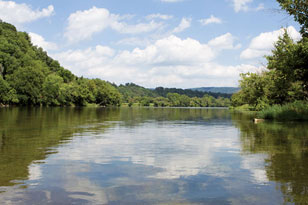
The Holston River downstream of Zone 6.
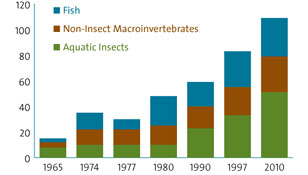
The chart illustrates the numbers of different types of aquatic insects, non-insect macroinvertebrates, and fish that have been recorded throughout Zone 5 near Riverfront Park during the seven Academy studies. Historic comparisons among surveys and zones need to take into consideration the levels of effort, and changes in zone boundaries and sampling techniques for each study.
Four main general conclusions can be drawn from the Academy’s 2010 study of the South Fork Holston and Holston rivers and Horse Creek near Kingsport, TN.
- A major stressor affecting biological communities continues to be Fort Patrick Henry Dam, with biological communities being most disturbed at Zone 2 and improving downstream.
- Water quality tests and biological communities show effects of nutrient enrichment downstream of the dam, which may come from a variety of industrial, municipal, and watershed sources.
- The status of biological communities is similar to that seen in the Academy’s 1990 and 1997 studies, with evidence of some improvement after 1997 in parts of the study area, e.g., Zone 3.
- There was no evidence of biological impacts from Eastman operations at the Horse Creek zones.
For more information, download the Academy of Natural Sciences of Drexel University’s report 2010 South Fork Holston River Environmental Monitoring Studies. This report will also be available at the Kingsport Public Library.
Credits
Written by Roger L. Thomas and Dr. Richard J. Horwitz
Edited by Robin S. Davis
Illustrations by Stephanie Gleit and Roger L. Thomas
Photographs by The Academy of Natural Sciences of Drexel University Archives, Raymond W. Bouchard Jr., Eastman Photographic Services, Kelly Hammonds, Keri Hochstetler, Jim Negus, John W. Sherman, and Roger L. Thomas